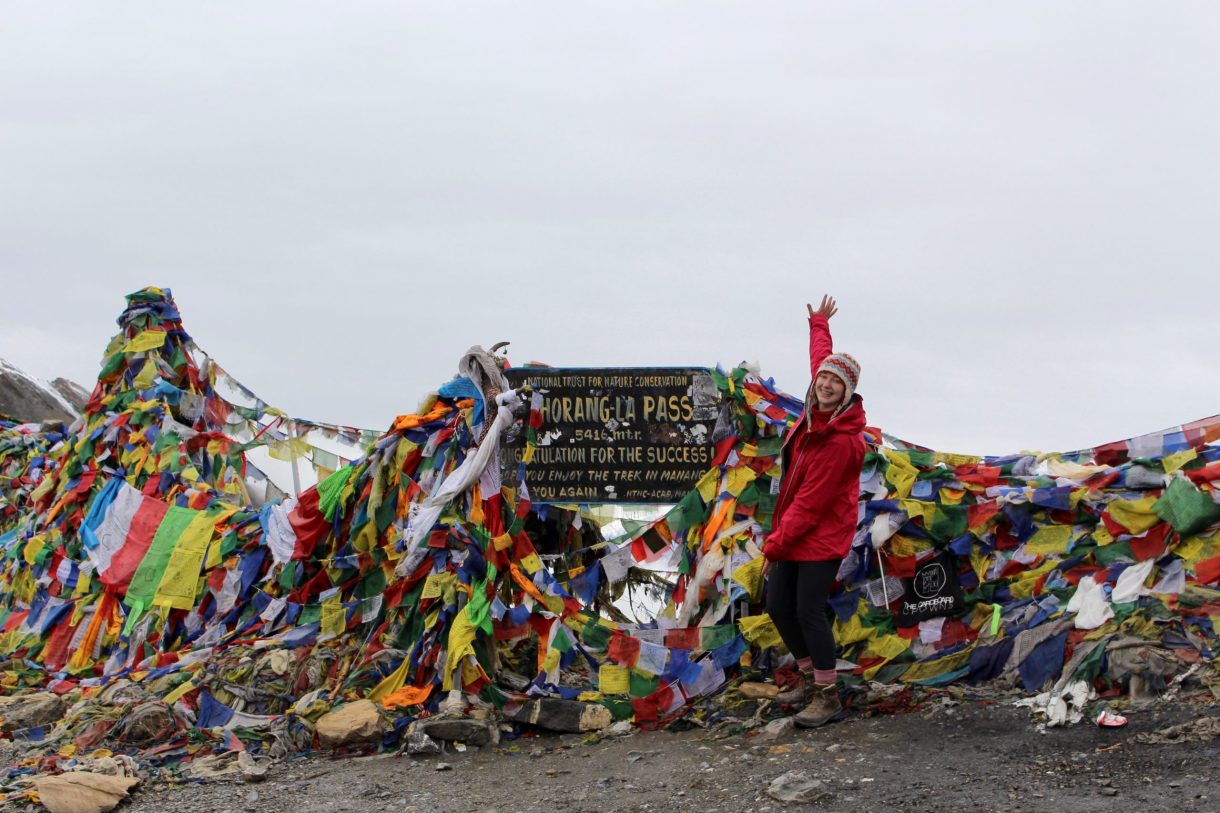
Hiking the Annapurna Circuit in Monsoon Season: the Ultimate Guide [updated 2025]]
Dreaming of trekking through the towering Himalayas but wondering if the monsoon season might put a damper on your plans? The Annapurna Circuit is a bucket-list adventure for many, offering breathtaking scenery, diverse landscapes, and a chance to immerse yourself in Nepal’s rich culture. But monsoon season – spanning from June to September – brings unique challenges and questions. Is it worth braving the rain for this iconic trek? Can you truly experience its magic amidst heavy downpours, landslides, and leech-filled trails
In this guide, we’ll uncover everything you need to know about hiking the Annapurna Circuit during monsoon season. From trail conditions and weather expectations to packing essentials and insider tips, we’ll help you decide if this wet-season adventure is right for you. Spoiler: the monsoon brings a greener, quieter Annapurna experience – if you’re prepared for the challenge.
In a rush? Jump straight to the relevant section here!
Click any of the bullets below to be taken straight to that section
- What is the Annapurna Circuit?
- Where is the Annapurna Circuit?
- What is the best time to hike the Annapurna Circuit?
- Why hike the Annapurna Circuit in Monsoon Season?
- Our experience of hiking the Annapurna Circuit in Monsoon Season
- What to pack for hiking the Annapurna Circuit in Monsoon Season
- Do I need a guide to hike the Annapurna Circuit in Monsoon Season?
- How to adjust to altitude in Nepal and the Annapurna Circuit
- FAQs
WHAT IS THE ANNAPURNA CIRCUIT?
The Annapurna Circuit is one of the most popular trekking routes in Nepal, and one of the most renowned in the world. It’s a bucket-list adventure for many travellers, including me!
Trekking the Annapurna Circuit involves wandering through an incredible diversity of landscapes. You’ll encounter lowland farming areas, dense forests, terraced fields, alpine meadows, and high mountain deserts. You’ll also get to pass through and stay in some super rural villages, offering a glimpse into the rich cultural tapestry that is Nepal.
The trail is dotted with teahouses and lodges, providing trekkers with accommodation and meals of varying levels of luxury, depending on your budget of course. This makes the trek more accessible and convenient as there’s no need to carry camping equipment and food supplies. You just strap on your backpack, and off you go!
WHERE IS THE ANNAPURNA CIRCUIT?
The Annapurna Circuit is in the central region of Nepal, in the Annapurna Himalayas. It’s a couple of hours drive from Kathmandu – unlike the Everest Base Camp trek, you won’t need to take a flight to get to the start point! The trekking route encircles the Annapurna Massif, which is a subrange in the Himalayas.
Here’s a map of the route. Zoom out to see where in Nepal it’s situated!
WHEN IS THE BEST TIME TO HIKE THE ANNAPURNA CIRCUIT?
We’re firm believers that there is no ‘best time’ to visit a destination. First of all, each season brings its own pros and cons. Secondly, what’s ‘best’ for one person may not be what suits another! Here, we’ll aim to give you an overview of what to expect when hiking the Annapurna Circuit throughout the year.
HIKING THE ANNAPURNA CIRCUIT IN SPRING & AUTUMN
Spring (March to May) is widely considered the best time to trek the Annapurna Circuit. The weather is usually stable, and the temperatures are usually mild and pleasant. The rhododendron forests along the trail bloom in spring, bringing colour to the valleys. The skies are generally clear, so you’re likely to get good views.
However, as Spring and Autumn are the most popular time to hike the Annapurna Circuit, you can expect it to be busy on the trails! If you’re the type of person who likes a bit of peace and quiet on. your hikes, Annapurna in Spring or Autumn may not be for you – you’ll be part of a convoy of people throughout your hike. This can be really nice, as you’ll bump into the same people hiking the same section of the route each day. However, teahouses and restaurants may be full, meaning you’ll need to plan ahead and can’t be as spontaneous.
Autumn (September to November) is also a popular time to hike the Annapurna Circuit. The monsoon rains clear out, leaving lush green scenery and crisp clear air – perfect for beautiful views.
HIKING THE ANNAPURNA CIRCUIT IN SUMMER
Summer (June to August) brings the monsoon season, with heavy rainfall and landslides across Nepal. This means a lot of Nepal’s trekking routes are closed. Those that aren’t can be slippery, dangerous, and downright unenjoyable, with epic mountain views obscured behind thick clouds.
However, the Annapurna Conservation Area is mostly in the Rain Shadow which means it stays relatively dry year-round (there’s more on that later). Everyone warned me against hiking in Nepal in the monsoon, but I only had time to take the trip in summer , so that was when I went!
HIKING THE ANNAPURNA CIRCUIT IN WINTER
Annapurna Circuit during the winter months (December to February) due to cold temperatures, snowfall, and the risk of avalanches, making the trail challenging and potentially hazardous. You’ll be looking at some serious winter mountaineering, including the gear and know-how to go with it. That said, winter offers stunning, snowy views. If you can brave the cold, it might be worthwhile!
WHY HIKE THE ANNAPURNA CIRCUIT IN MONSOON?
Hiking the Annapurna Circuit during the monsoon season might seem unconventional, but can be really enjoyable too. I hiked the Annapurna Circuit in the monsoon season because it was the only time I could take before I started a new job. Here’s why I loved hiking the Annapurna Circuit during monsoon season:
#1 THE LANDSCAPES ARE BRILLIANTLY GREEN
The monsoon season, which typically runs from June to September, transforms the usually barren landscapes of the Annapurna region into lush, vibrant greenery. The hills and valleys come alive with blooming flowers, creating a picturesque and refreshing atmosphere.
#2 THERE ARE FEWER TOURISTS
Hiking the Annapurna Circuit during monsoon season means there are significantly fewer tourists on the trails. If you prefer a quiet or mindful trek, this is the perfect time to experience the Annapurna Circuit without the crowds. You’ll have the trails, teahouses, and viewpoints more to yourself, allowing for a more intimate connection with the surroundings. The rest of Nepal will be similar!
#3 YOU'LL MAKE BETTER CONNECTIONS
The local communities along the Annapurna Circuit are less busy during the monsoon months, so they’ll have a bit more time to hang out, chat, or play cards. You’ll end up having some really genuine conversations, learn about local traditions, and experience the authentic mountain culture without the hustle and bustle of peak tourist season. Remember to pack a set of playing cards. These are great for bonding with locals, despite language barriers, as most cultures play variations of similar card games.
#4 IT'S SIGNIFICANTLY CHEAPER
Accommodations and services along the route tend to be more affordable during the monsoon season due to lower demand. If you’re travelling on a budget (like I was!) this can be a significant advantage, allowing you to save on accommodation, food, and other expenses.
#5 YOU CAN SUPPORT THE LOCAL ECONOMY IN THE OFF-SEASON
Off-season can be a slow couple of months for many local people who rely on hiking tourism in the Annapurna region. Think Sherpas, Guides, Guesthouse owners, etc. Hiking off-season allows these people to earn an income and continue to support their families throughout the low season. This is a really great way to support local economies: a pillar of sustainable travel.
#6 YOU PROBABLY WON'T EVEN GET RAINED ON!
The majority of the Annapurna Circuit is in the Rain Shadow. The area is less vulnerable to rainfall due to the geography of the mountains. If it rains, it mostly happens overnight which means you are not likely to be soaked wet while trekking the Annapurna Circuit in monsoon season. We only experienced heavy monsoon rain on the first two nights, and never during the day. And after the first night, we didn’t get wet at all!
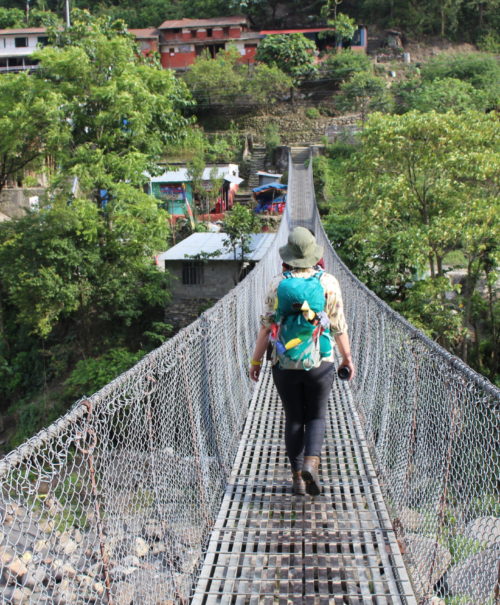

Setting off from Besi Sahar
MY EXPERIENCE OF HIKING THE ANNAPURNA CIRCUIT IN MONSOON SEASON
Update Jan 2025: OK, time for a bit of a travelogue! This was my very first blog post… ever… and, whilst I don’t love the travelogue style anymore, I still really enjoy looking back on this record of my experience and seeing how far I’ve come! Enjoy…
Day 1: Besi Sahar to Bhulbhule
Wanting the full Nepal experience (and ever conscious that I’d just-graduated-from-university and had almost no wiggle room in my budget), I opted to take the locals’ bus to the start point. Backpacks on the roof and Bollywood music blaring from tinny bus speakers, we rode the bus to Besi Sahar (800m). It was hot and humid and we were sweating before we’d set off to begin the afternoon’s hike to Bhulbhule.
That night I experienced the most violent thunderstorm of my life. Huddled in our cabin with lightening flashing through the cracks in the wood of our teahouse, I questioned my sanity.
“Why did I choose to hike the Annapurna Circuit in the Monsoon Season?”
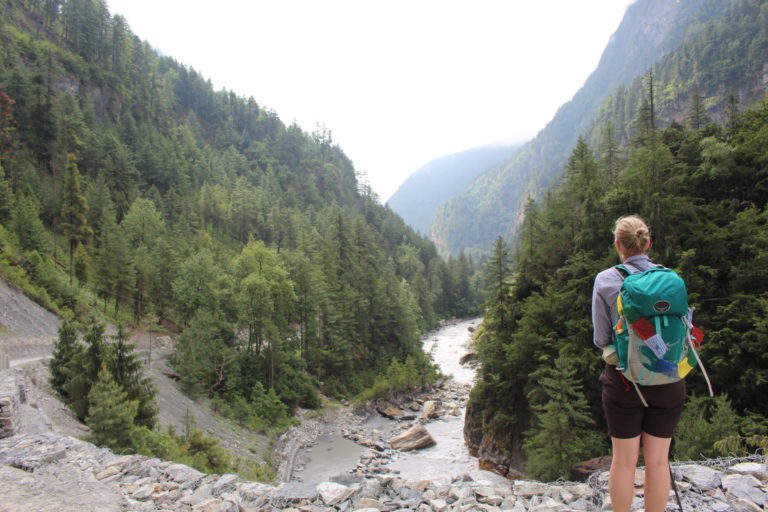
First days on the Annapurna Circuit
Day 2/3: Jagat to Chame Bazaar to Pisang
The next morning was bright and cool and we were blessed with good weather. The trail wound upwards through the mountains with the heavy humidity and lush tropical greenery being replaced by a cool breeze and conifers!
When we paused to catch our breath, Nepalese women rushed out with steaming cups of hot chai and loaded plates of Dahl Bhat or Momos (Nepalese dumplings). Absolutely delicious!
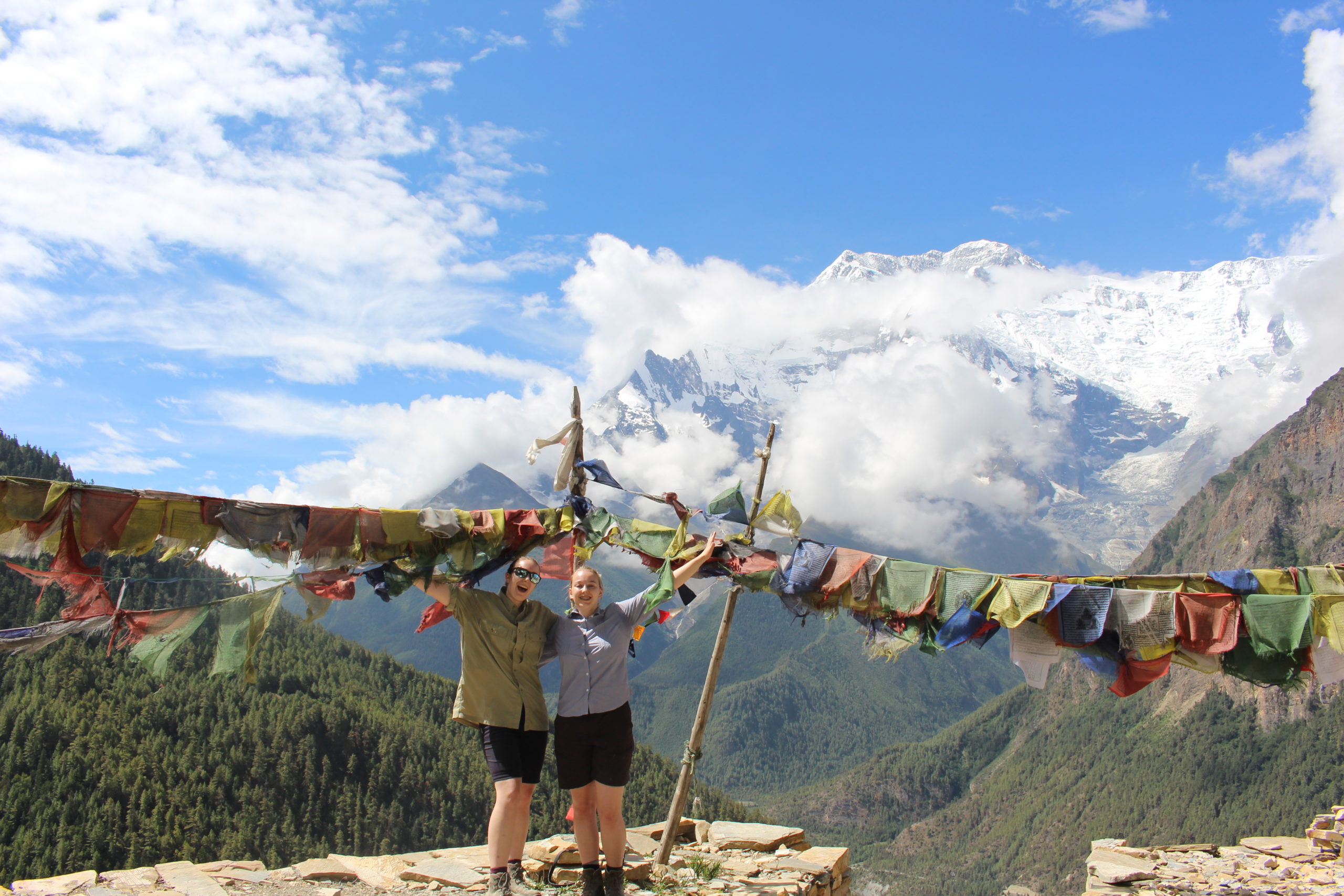
Views of Annapurna II: a Mountain over 8000m high
Day 4: Pisang to Manang
Leaving Pisang to pass through the small village of Ghyaru, was one of the steepest inclines of the trek. With the weather hot enough to still be uncomfortable, we struggled up the neverending slopes. As we arrived at Ghyaru, the clouds parted to reveal the most beautiful views of Annapurna II, the second highest peak in the Annapurna range. Obviously, we stopped to enjoy this view with a well-deserved cup of chai.
Having had limited access to the internet, we were looking forward to an acclimatisation day in Manang where we would be able to update our family on our trek so far (mostly convincing my mum we hadn’t died yet). However, Manang shares their power supply with a neighbouring village. We arrived in the middle of a power outage, so spent our acclimatisation day napping, eating and playing endless rounds of cards with the locals.
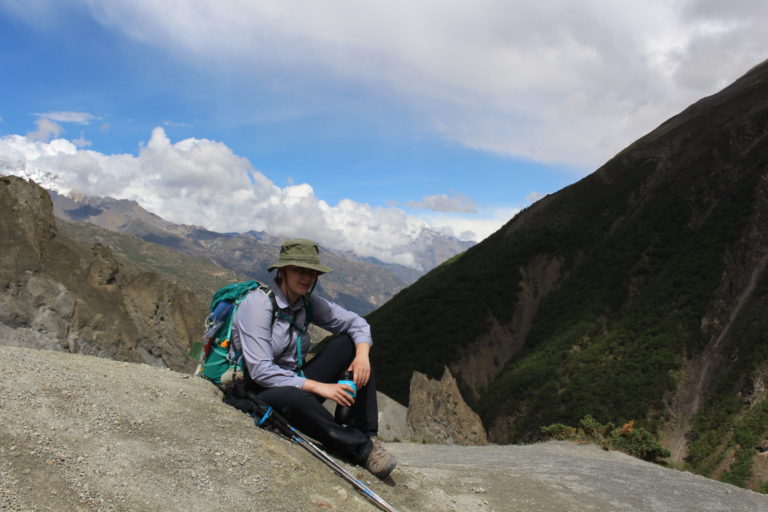
Water break with my trusty Water to Go filter bottle
Day 5: Manang side trek to Tilicho Lake
Rested up and itching to get back on the trail, we set off to Tilicho Base Camp, traversing a landslide where one false step would have sent us tumbling to the bottom of a deep valley. We made good progress, arriving at the first teahouse before noon, and pushed on to the Base Camp.
This meant we covered two-days in one, which worked out really well. This tiny change in our itinerary led to me meeting my future partner and the hidden half of Discoveny, Marius, later on in our trip! Talk about the butterfly effect!
Day 6: Tilicho Lake
We arose at 4am the next morning, sleepily pulling on hats, coats and boots. It was freezing, and I’d slept in my clothes the night before. Dragging ourselves to the dining room, we were greeted with steaming bowls of spiced porridge and hot chai. We left Tilicho Base Camp in the morning twilight, the air cool and fresh on our faces as we began the ascent to Tilicho Lake, the highest lake in the world.
Shivering from the high-altitude temperatures, we gazed across at the turquoise waters of Tilicho Lake, warming our hands on a flask of hot tea. Avalanches crashing down into the lake occasionally broke through the silence of the four of us taking in the view.

The highest lake in the world: Tilicho Lake!
Day 7 - 9 : Tilicho Base Camp to Manang to Thorong High Camp
The next few days passed in an altititude-induced blur as we retraced our steps back to Manang to re-join the Annapurna Circuit trail. I was sick (yep, traveller’s tummy caught up with me eventually) and feeling the effects of high altitude, so this was a really rough few days.
On day 8, we spent the night at Thorong High Camp (4700m), a lone tea house in the middle of a barren landscape, with mountains towering above. I had the worst altitude headache here. This mild symptom of altitude sickness is normal and expected, but I still felt absolutely awful.
Day 10 : Thorong La Pass
We strapped on our head torches and set off before the sun. As we struggled up the last uphill section of the Annapurna Circuit, we watched the sky gradually lighten, finally arriving at Thorong La Pass, the highest point of the trek. We had made it at last.
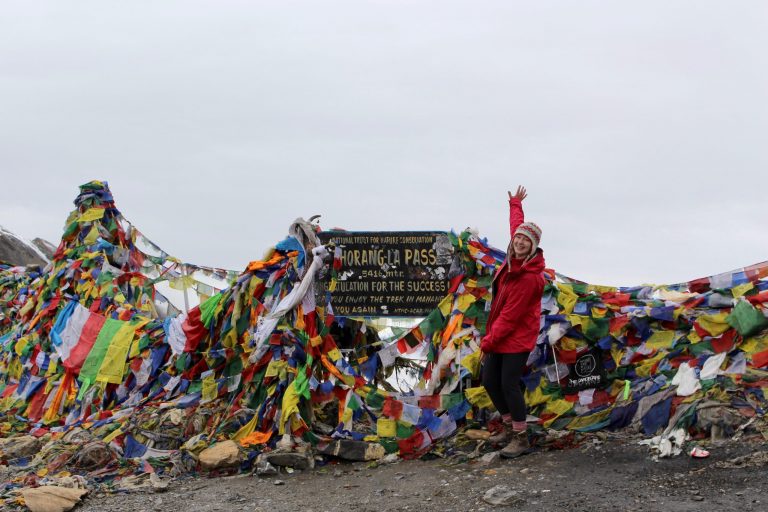
Feeling extremely excited at Thorong La Pass
Day 11 - 13 : Thorong La Pass to Jomsom
After reaching Thorong La Pass, it was an easy breeze downhill. We could feel the oxygen increasing with every step, breathing became easier and my headache subsided. Eventually, we reached Jomsom, and settled into the final teahouse on our trek.
Of course, this wasn’t the end of our time in Nepal. We carried on to Pokhara, experiencing the craziest bus ride on the way. We spent time in Chitwan National Park learning how to be elephant friendly tourists on an Elephant Happy Hour. And of course we explored Kathmandu on our return.
WHY WE RECOMMEND HIKING THE ANNAPURNA CIRCUIT IN MONSOON SEASON
- You’ll have the entire trail to yourself. It’s so peaceful.
- It’s not too cold. You can leave the heavy layers at home which means less weight to carry.
- Less competition among trekkers for accommodation means that you can wake up anytime you want in the morning, stop for as many cups of tea you want along the way, and arrive at a tea house as late as you want in the evening.
- Free Wi-Fi. Many tea houses will not charge you for WiFi during the low season.
- Fewer blackouts. Less trekkers means more electricity to go around.
- The summit is all yours. You can stay as long as you need and take as many photos as you like with no other tourists in your way.
WHAT TO PACK FOR TREKKING THE ANNAPURNA CIRCUIT IN MONSOON SEASON?
Traditional hiking gear will get you a long way on this trek. Make sure you have waterproof, well-broken-in hiking boots with good ankle support as you’ll be spending every day in them. You’ll need comfortable hiking clothes including trekking trousers (not jeans!) and a breathable base layer.
In fact, layering is key for this trek due to the difference in altitude and temperatures at the base and the summit. At 700m it can be above 30°C (shorts and t-shirt weather) but Tilicho Lake and Thorong-La Pass can be below freezing in the early hours of the morning. Layer layer layer! Make sure you test out your kit before hiking the Annapurna Circuit to ensure it’s comfortable and durable, it’s difficult to find good kit up there.
CLOTHING
- Wind-proof and water-proof jacket (it doesn’t rain a lot but it’s good to be prepared
- Light insulating layer, such as a fleece jumper.
- Down jacket (good for those cold nights at altitude)
- Technical base layers (we recommend merino wool tops and leggings)
- Trekking trousers or leggings
- Sturdy walking boots
- Hat, gloves, and buff
KIT
- Backpack to carry all your things.
- Sleeping bag and sleeping bag liner (APC has a huuuuge range of temperatures, be prepared)
- Water filtration device (we recommend Water-to-go bottles, I also brought a Katadyn micro filter, I’d use that if travelling as a group)
- Trekking poles
OTHER
- First aid kit
- Any prescription medication
- Basic toiletries (toothpaste, lip balm, sanitiser etc)
- Head torch + batteries
- Camera + charger
- Portable charger (electricity can be scarce)
- Kindle (Never without it!)
DO I NEED A GUIDE TO HIKE THE ANNAPURNA CIRCUIT IN MONSOON SEASON
That depends on your trekking experience, comfort level, and personal preference. The trail is well-marked, and many trekkers choose to go without a guide, especially if they have prior trekking experience in high-altitude regions. Not hiring a guide and/or porter means that you can go at your own pace. In the off-season, you often don’t need to pre-book accommodation, so a guide is not needed to pre-book and plan your trip. Going without a guide can also help you to save money.
However, hiring a local guide can enhance your experience by providing insights into the culture, ensuring safety, and helping with logistics. If you’re not confident in your navigation skills or if it’s your first time trekking in the Himalayas, having a guide is advisable. A good guide will also be trained to spot the signs of altitude sickness, and carry altitude adjustment medication and oxygen in case of emergency.
Note: If you don’t hire a guide or porter, you will have to carry all your gear. You’ll meet a lot of hiking purists who argue that carrying all of your gear somehow makes you a ‘better hiker‘ and that to not do so is ‘cheating’ and you ‘haven’t really completed the hike’. Do what feels better for you. I honestly don’t think that I would have enjoyed this trek half as much if I’d had to carry my big backpack, and hiring a porter was the best thing we did.
The Annapurna Circuit is easy enough to hike alone. But if you are looking for a trekking company to organise this for you I can recommend Trek Around Nepal. We booked our trek and everything was organised, from pick-up in Kathmandu to our trek completion in Pokhara.
HOW TO AVOID ALTITUDE SICKNESS WHEN HIKING THE ANNAPURNA CIRCUIT
Altitude sickness, or acute mountain sickness, is a common illness experienced at high altitudes. It happens when travellers and hikers ascend to high altitudes too quickly, without giving their bodies time to adjust to the reduced oxygen levels. The main symptoms of AMS include headache, shortness of breath, nausea, lightheadedness, dizziness, indigestion and loss of appetite.
It doesn’t matter how fit you are, or if you’ve avoided altitude sickness before. There’s no guarantee that it won’t affect you this time. I was fine hiking the Annapurna Circuit in Nepal (5417 metres), and reaching the summit of Mount Toubkal in Morocco (4167 metres). However, I experienced mild altitude sickness when hiking up to Rainbow Mountain and Red Valley in Peru (which isn’t even as high at 5200 metres!).
The best way to avoid altitude sickness in Nepal is to avoid going up too high, too fast. This means increasing your altitude by less than 500 metres a day. Any guided hike in Nepal will adhere to this recommendation. You’ll climb high, but drop down to a lower altitude to sleep, giving your body time to adjust
There are a few other things you can do to reduce the severity of altitude sickness. Hike slowly and don’t rush around, it’s not a race after all. It’s really important to stay hydrated, so sip plenty of water throughout the day. You can also eat lighter meals and don’t eat too quickly. The locals will tell you to take coca leaves, tea, or sweets, which may help. You can also buy over-the-counter altitude sickness tablets (such as Diamox) in Kathmandu. But these should be used as a last resort!
Disclaimer: these tips are just a few things that have helped me. You should always consult a medical professional for any medical advice.
SHOULD I DO THE ANNAPURNA CIRCUIT OR THE EVEREST BASE CAMP IN MONSOON SEASON?
The choice between the Annapurna Circuit and the Everest Base Camp trek depends on your preferences, fitness level, and what kind of experience you’re seeking.
Choose the Annapurna Circuit if:
- You prefer a diverse trek with a mix of landscapes, from subtropical forests to alpine deserts.
- You want to experience a wide range of cultures and communities as the circuit passes through various ethnic villages.
- You’re looking for a more extended trek (typically 15-20 days) with a variety of scenery and fewer crowds than Everest Base Camp.
- You don’t want to get absolutely soaked in the monsoon rain!
Choose the Everest Base Camp Trek if:
- You want to see the world’s highest peak, Mount Everest, up close and witness breathtaking panoramic views from Kala Patthar.
- You prefer a shorter trek (usually 12-14 days) with a well-trodden route and established teahouses along the way.
- You’re interested in the unique Sherpa culture and the opportunity to visit monasteries like Tengboche Monastery.
- You don’t mind a bit of rain!
Both treks offer incredible experiences, so consider your interests, physical condition, and the amount of time you have available when making your decision. Many trekkers eventually return to Nepal to experience both, given their distinct charms and challenges. I can’t wait to return to Nepal to hike in the future!

FAQs
Q: IS THE ANNAPURNA CIRCUIT STILL WORTH IT IN 2023?
A: The Annapurna Circuit remains one of the most iconic and popular trekking routes in Nepal. With its breathtaking scenery, diverse landscapes, and cultural experiences, it offers an unparalleled trekking adventure in the heart of the Himalayas. It’s definitely still worth it and makes a great introduction to trekking in Nepal!
Q: IS THE ANNAPURNA CIRCUIT DANGEROUS?
A: The Annapurna Circuit is a popular route. The Nepalese are kind, genuine people and you’re unlikely to experience any issues with harassment or petty crime. The most dangerous thing is probably the high altitude and changing weather conditions. However, with proper preparation, a reputable guide, and attention to safety guidelines, the trek is very safe!
Q: IS THE ANNAPURNA CIRCUIT HARD?
A: Well, it’s certainly not a walk in the park! The Annapurna Circuit involves long hours of walking each day, varying weather conditions, and high-altitude terrain. Trekkers should be physically fit, mentally prepared, and have some prior trekking experience to fully enjoy and successfully complete the trek.
Q: HOW LONG IS THE ANNAPURNA CIRCUIT?
A: The Annapurna Circuit trek typically covers a distance of approximately 160 to 230 kilometers (100 to 145 miles) depending on the specific route taken. The duration of the trek can vary, but most trekkers complete the circuit in about 15 to 20 days, allowing for acclimatization and enjoying the scenic beauty along the way.
Q: HOW HIGH IS THE ANNAPURNA CIRCUIT?
A: The highest point of the Annapurna Circuit is Thorong La Pass, which stands at an elevation of 5,416 meters (17,769 feet) above sea level. Thorong La Pass is the highest trekking pass in the world and a significant achievement for trekkers completing the circuit.
Q: CAN YOU HIKE THE ANNAPURNA CIRCUIT ON YOUR OWN?
A: You do not need a guide to hike the Annapurna Circuit. However, hiking alone anywhere is bad practice: what if something were to happen? You should always hike with someone else, or if this is not possible, let someone know when you are setting off, and your planned route. See our section on ‘Do I need a guide’ for more information.
Q: HOW MUCH DOES THE ANNAPURNA CIRCUIT COST?
A: The cost of trekking the Annapurna Circuit varies a lot! A moderate budget trekker can expect to spend around $20 to $50 USD per day on food, accommodation, and permits. If you choose to hire a guide and/or porter, the cost will obviously increase. You should also factor in transportation to and from the trekking start and end points.
Q: WHERE DOES THE ANNAPURNA CIRCUIT START AND END?
A: The Annapurna Circuit usually starts in Besi Sahar. Starting any further up is not recommended, as it won’t give you time to adjust to the altitude. The hike ends in Jomsom.
Q: WHAT TO DO FOR WATER FILTRATION IN NEPAL (ANNAPURNA CIRCUIT)?
A: Save money and save the planet by bringing a Water filtration device. You don’t need to splash the cash on one of these. We recommend Water-to-go bottles. You can click the link to get a 15% discount, or check out our full review here.
Q: WHAT ARE THE DIFFERENCES BETWEEN COMPANIES OFFERING ANNAPURNA TREK?
A: Companies will vary in their staff expertise, services offered, group size, itinerary, safety measures, environmental responsibility, cost, flexibility, and customer support. A more expensive tour company might be foreign-owned. It may be all-inclusive and offer premium accommodation and transport options. A cheaper tour company might be locally owned. It may offer more basic accommodation and may not be all-inclusive.
Q: WHAT ARE THE HIGHLIGHTS OF THE ANNAPURNA CIRCUIT?
A: The Annapurna Circuit trek highlights include the challenging Thorong La Pass, diverse landscapes from subtropical forests to high deserts, cultural immersion with local communities, natural wonders like the Kali Gandaki Gorge, serene lakes, and charming towns such as Jomsom and Marpha. You’ll also encounter ancient villages, enjoy natural hot springs, relish local cuisine, and witness stunning sunrises and sunsets against the majestic Himalayan backdrop.
Disclaimer: The information and advice provided in this blog are the author’s opinions and based on their personal experiences. All information was accurate at the time of writing. However, things can change quickly, so always double-check current conditions and guidelines before setting out. Remember, your travels and safety are your own responsibility, and this blog can not be held responsible for anything that might happen on your adventures! Always exercise caution and good judgment. Oh, and don’t forget to get travel insurance! Happy travels!
This post may contain affiliate links (yay for transparency!) This means that I will earn a small commission, at no additional cost to you, if you click the link and choose to buy the product. I only link to stuff I have personally bought and found useful and never endorse crap. Your support helps keep the site going, thank you!
Alice
Alice is a UK travel blogger who advocates sustainable travel and being more eco-conscious on a budget. She loves coffee, her houseplants and summiting mountains.
You May Also Like

Is your Travel Photography Ethical?
February 19, 2022
Vegan in Mongolia: How to NOT starve
January 16, 2021
4 Comments
Marius
Great article and amazing pictures. I hope I can hike it one day.
Alice
Thank you! I hope to hike it again and experience different seasons 🙂
Charlotte Furze
Great blog Alice, you’re a great writer! I’m really enjoying reading about your travels and you’ve taken some fab photos too.
Keep it up ✌
Alice
Thank you so much 🙂